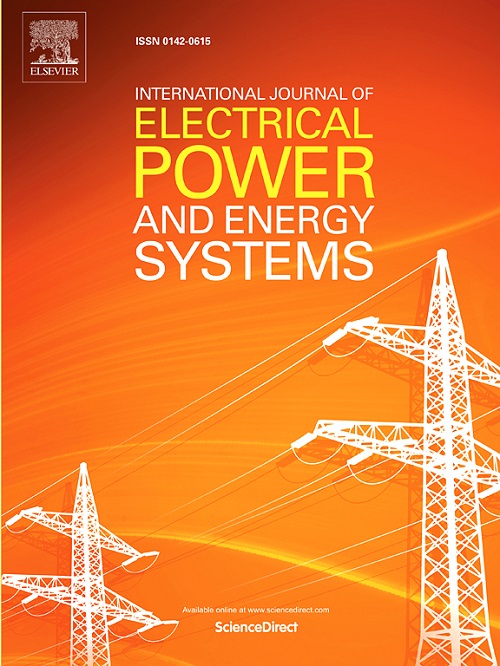A novel principle of frequency characteristics-based current differential protection for outgoing lines of wind farms
IF 5
2区 工程技术
Q1 ENGINEERING, ELECTRICAL & ELECTRONIC
International Journal of Electrical Power & Energy Systems
Pub Date : 2025-04-04
DOI:10.1016/j.ijepes.2025.110645
引用次数: 0
Abstract
With the development of renewable energy sources, conventional power frequency-based protection schemes face performance decrease problems. Studying the transient characteristics of faults is crucial for increasing the protection performance for outgoing lines of wind farms. In this paper, the transient dominant frequency component of the fault differential current in the outgoing line is quantitatively analyzed based on the lumped parameter line equivalent method and the frequency impedance of the wind farm. At the initial stage of fault transient, a novel principle of current differential protection within a 5 ms fault window is proposed using the composition difference between the dominant frequency component and power frequency component in external and internal faults. Afterwards, based on the time–frequency analysis method of wavelet transform, the power frequency component and the transient dominant frequency component are calculated and considered as the action and braking energies, respectively. The composition of the frequency band for energy calculation is then optimized based on the characteristics of the wind farm outgoing line. This allows to significantly improve the sensitivity and reliability of the protection. Finally, the proposed scheme is evaluated through PSCAD simulation and dynamic experiment. The results of the dynamic experiment, which relies on physical models, demonstrated the correctness of the theoretical analysis and the high performance of the proposed protection scheme. The experiment results show that the proposed protection scheme, which is not affected by the CT saturation and requires sampling frequency of only 10 kHz, can identify internal faults in 6–7 ms.
一种新的基于频率特性的风电场出线电流差动保护原理
随着可再生能源的发展,传统的基于功率频率的保护方案面临着性能下降的问题。研究故障暂态特性对提高风电场出线保护性能至关重要。本文基于集总参数线路等效法和风电场的频率阻抗,定量分析了出线故障差动电流的暂态优势频率分量。在故障暂态初始阶段,利用外部故障和内部故障中主频分量和工频分量的组成差异,提出了一种新的5ms故障窗电流差动保护原理。然后,基于小波变换的时频分析方法,计算了功率频率分量和暂态优势频率分量,分别作为动作能量和制动能量。然后根据风电场出线的特点,优化能量计算频带的组成。这可以显著提高保护的灵敏度和可靠性。最后,通过PSCAD仿真和动态实验对该方案进行了验证。基于物理模型的动态实验结果证明了理论分析的正确性和所提出的保护方案的高性能。实验结果表明,该保护方案不受CT饱和影响,采样频率仅为10 kHz,可在6 ~ 7 ms内识别出内部故障。
本文章由计算机程序翻译,如有差异,请以英文原文为准。
求助全文
约1分钟内获得全文
求助全文
来源期刊
CiteScore
12.10
自引率
17.30%
发文量
1022
审稿时长
51 days
期刊介绍:
The journal covers theoretical developments in electrical power and energy systems and their applications. The coverage embraces: generation and network planning; reliability; long and short term operation; expert systems; neural networks; object oriented systems; system control centres; database and information systems; stock and parameter estimation; system security and adequacy; network theory, modelling and computation; small and large system dynamics; dynamic model identification; on-line control including load and switching control; protection; distribution systems; energy economics; impact of non-conventional systems; and man-machine interfaces.
As well as original research papers, the journal publishes short contributions, book reviews and conference reports. All papers are peer-reviewed by at least two referees.

 求助内容:
求助内容: 应助结果提醒方式:
应助结果提醒方式:


